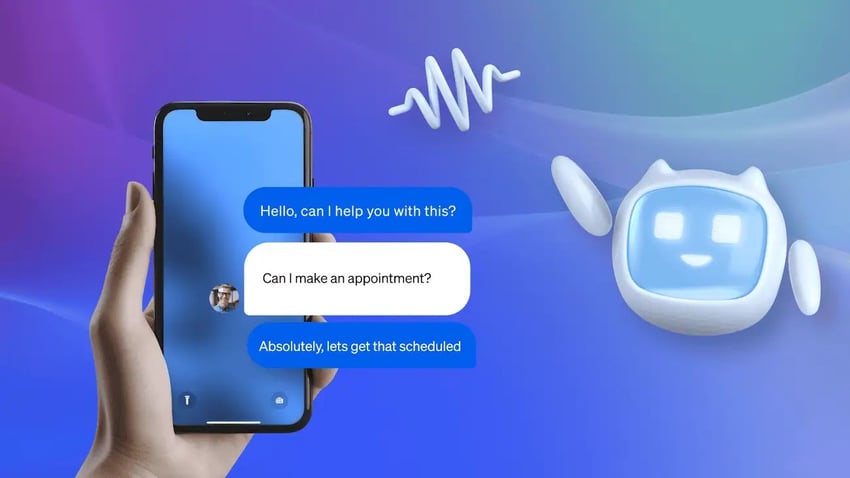Cold calling is effective, but it works at a slow pace.
A Gong study of 300 million calls found the average rep connects on only 5.4% of cold calls, and top reps around 13.3%. This means that if an average rep dials 100 calls, only five connect to live prospects in reality. The other 95 calls lead to no results.
Consider an agent manually dialing these 95 numbers, waiting for the prospect to pick up, and ultimately hearing no response. It’s a loss of time, effort, and most importantly, opportunities not tapped since your team was on other unanswered calls.
A cold call dialer saves time and effort.
What Is a Cold Calling Dialer?
A cold call dialer is software that automates the dialing process for outbound sales teams. It automatically dials numbers based on a dialing list, ensuring agents are connected to live prospects, not their answering machines.
If it reaches an answering machine, the software automatically drops prerecorded voicemails to encourage buyers to call back. The dialing software integrates with a CRM to update logs and outcomes of the call. It allows agents to follow up effectively and in a streamlined fashion.

Cold calling dialers reduce manual delays in connecting with a lead or prospect. They enable agents to increase their call volume and talk time, which are key measures in evaluating a sales agent’s performance. They increase agent productivity and offer real-time metrics and call analytics for the management team.
This way, improvement measures are implemented strategically, empowering agents to sell more effectively when they’re reaching out to the masses. Companies observe that 4.8% of cold calls result in meetings being booked. It makes calling efficiency even more crucial, echoing the need for reliable cold call dialers.
Types of Dialers for Cold Calling
Below are some popular types of dialers that give technological support to call center agents for cold calling.
1. Preview dialers
A preview dialer displays the lead’s details to a representative, allowing them to review the information before pressing “dial.” This helps an agent get their context right and tailor their pitch to the prospect’s likes and business needs.
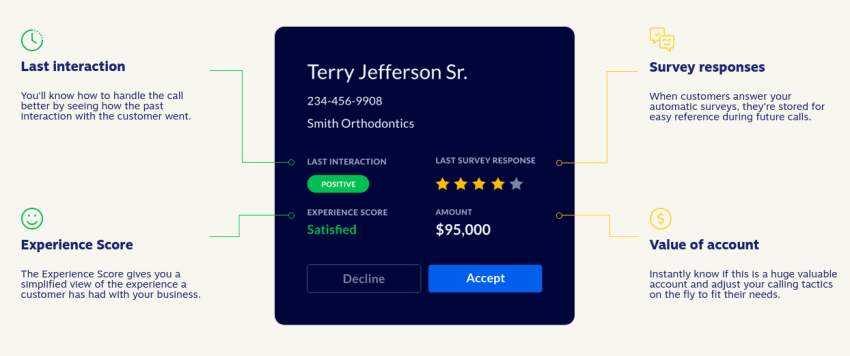
This brings personalization into the conversation, helping the brand deliver a memorable experience. It’s a preferred approach for high-value sales or calls that are sensitive to compliance requirements. However, it has a slower throughput. You operate at a limited call volume, as the dialing involves manual work where you must click and confirm each call.
If you’re looking for higher quality talk time but don’t need as much quantity, the preview dialer is a suitable option.
Below are some pros and cons of preview dialers to help you make an informed choice.
 Pros
Pros
Allows agents to review lead details before the call
Higher call personalization and relevance
Better for complex or high-value sales conversations
Reduces the risk of calling the wrong contacts or making mistakes
Helps new agents gain context and improve confidence
 Cons
Cons
Slower call volume compared to power or predictive dialers
Requires manual confirmation before each call
Less efficient for high-volume outbound campaigns
Gives agents too much time between phone calls
Not ideal for boilerplate or transactional sales environments
2. Power dialers
Power dialers are also known as rapid or automated sequential dialers. The sales dialer places one call after another at a fixed pace. When a call is answered, it connects to a free agent, skipping unanswered and busy calls. These dialers prioritize speed and simplicity, which are paramount for small sales and lead generation teams.
Cold calling agents waste less time between calls, improving their overall throughput. Agents add up more talk time without complicating the dialing process. However, due to limited control, agents often have little to no time to prepare for calls or prioritize potentially higher-value calls.

Below are some pros and cons of power dialers. This will keep you informed when selecting proper functionality for your call center.
 Pros
Pros
Automates dialing after each call ends
Increases agent talk time and call volume
Reduces agent downtime and manual dialing errors
Great for small to midsize teams focused on outbound
Works well with CRM integration and basic scripting
Simple to use and doesn’t require complex configuration
 Cons
Cons
Doesn’t screen for voicemail or busy signals in advance
Still connects one call at a time, limiting peak efficiency
Agents can feel rushed without prep time
Lacks advanced call pacing like predictive dialers
Can lead to burnout if the lead quality is low
Not ideal for very high-volume teams
Just like power dialers, there are progressive dialers that only call the next number when an agent is available. Although these dialers are slower than predictive dialers, they reduce abandoned calls because the available agent immediately answers the live call.
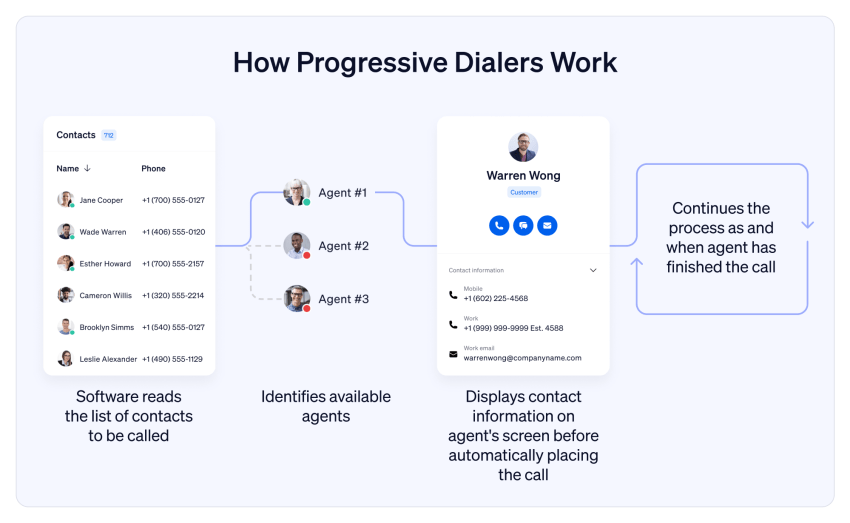
3. Predictive dialers
Predictive dialers use algorithms to simultaneously call multiple leads and connect the agent only when a person answers. You might have experienced this if you remember getting a call from a number and hearing a ring after answering. This is the work of a predictive dialer. After you answer the call, the dialer software then connects you with an available agent.
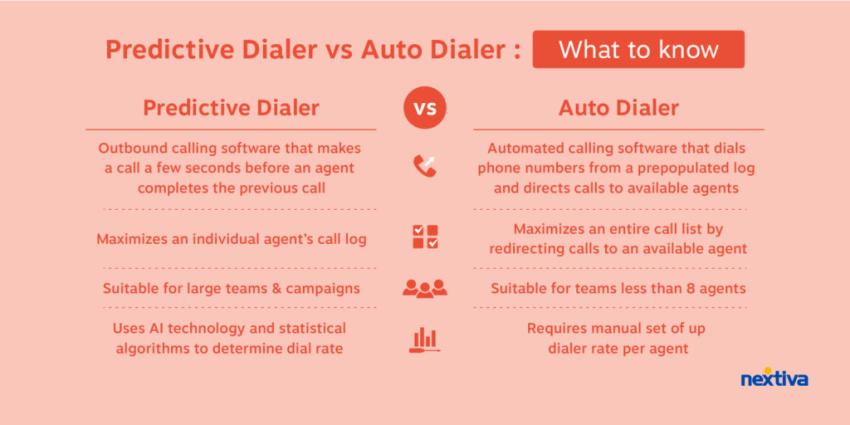
These are best suited for high-volume contact centers that want to maximize their throughput. However, the software comes with its challenges — there might be an increase in dropped calls if several prospects answer at the same time and no agent is available to talk to them.
There’s a clear advantage with predictive dialing on the talk time. It’s often 200% to 300% more than manual dialing. A research study observed that reps talked for 10-15 minutes per hour in manual dialing. The same reps’ talk time per hour jumped to 40-50 minutes with predictive or parallel dialing.
Below are some advantages and disadvantages of predictive dialing. This will help you see if the functionality is fit for your use case.
 Pros
Pros
Dials multiple numbers at once, increasing agent utilization
Maximizes call volume and throughput
Ideal for large-scale outbound teams
Reduces idle time between calls
Often includes call pacing algorithms
Works well in automated, script-heavy environments
 Cons
Cons
Risk of dropped calls if no agents are available when someone answers
Can violate TCPA and FCC regulations without proper configuration
Not suitable for personalized or consultative selling
More complex to set up and manage
May frustrate leads due to delays or silent connections
Requires close call monitoring for quality control and compliance
4. Manual dialing
This type of outbound dialer is preferred when you take one-off calls while ensuring hypertargeted outreach to the prospect. It gives you maximum control over who to call and when. It lets you take the time you need to get your pitch right and manually dial to connect with the prospect.
It’s highly inefficient for teams, as it makes the cold calling process slow. The chances of errors increase with manual workflows, resulting in increased cleanup work and other post-call activities, such as note-taking.

Below is an overview of the advantages and disadvantages of manual dialing.
 Pros
Pros
Complete control over call timing and contact choice
Best for hyperpersonalized or sensitive conversations
No risk of compliance issues from automated systems
Useful for one-off or high-value outreach
Can be done without any dialer software
 Cons
Cons
Time-consuming and inefficient for large volumes
High chance of human error in dialing numbers
Limited productivity — agents spend more time dialing than talking
No automation for voicemails, follow-ups, or CRM updates
Not scalable for modern outbound sales teams
Features to Look for in the Best Cold Calling Dialer
When it comes to a cold calling dialer, there are a few key features that are essential for an efficient contact center team. For example:
- CRM integration: Top dialers sync tightly with CRM systems like Salesforce or HubSpot. They automatically pull call lists and contact data and log call outcomes, recorded calls, and notes back into the CRM. This ensures no data is lost and keeps lead records up to date without manual entry.
- Adaptive AI and analytics: Modern dialers often include AI to optimize dialing pace and lead prioritization. They may also filter out likely voicemails or spam. Some AI dialers come with the ability to pause outgoing calls while a live conversation is in progress, allowing resources to be focused on active calls.
- Intelligent call routing: Advanced systems route live answers to the best agent. They recognize if the previous agent who spoke to a prospect is free and transfer accordingly, or select an available agent with the right skills.
- Agent assist and scripting: Many dialers provide screen pops or live coaching. For preview calls, the dialer shows contact details and previous notes just before the call. During calls, the agent assist features display dynamic scripts and even provide real-time guidance based on what the prospect says. This keeps reps prepared even in high-volume environments.
- Call automation tools: Look for one-click voicemail drop or leaving a recorded message without waiting. Ensure the vendor offers automated follow-up emails and SMS tied to call dispositions. It saves you time while making your contact attempts more consistent.
- Analytics and reporting: The ability to pull reports on key metrics, such as connection rate, talk time, conversions, and rep performance, is critical. Some solution providers even use speech analytics to understand sentiment and keyword triggers or deal signals in conversations. These insights help fine-tune scripts and train agents toward improvement.
- Compliance features: Good dialers embed compliance automation. This includes automatic do-not-call (DNC) list scrubbing on import, time-of-day call blocking, and often caller ID and spam filtering. AI dialers usually maintain consent flags and block any contact lacking consent. Call centers with AI-driven systems show a 40% reduction in compliance violations.
- Scalability and flexibility: A modern dialer should support multiple dialing modes like preview, power, progressive, and predictive, so you can adjust as team or campaign needs change.
Best Practices for Cold Calling Success
Cold calling is an effective outbound sales strategy. A study shows that even CEOs, who are the most challenging to connect with, answer cold calls 12% of the time. Although cold calling is helpful to reach prospects when the world is starving for attention, it has the potential to backfire when executed without caution or by just dialing numbers blindly.
Here are a few best practices that help a contact center team make the most of their cold calling efforts.
Warm up your cold call list
Even when you’re doing cold outreaches, start with qualified leads. It’s best to make use of your CRM or lead management platform to score and prioritize. This helps you reach out to warmer leads who have shown some interest in your brand.
It’s best to refine the lead data by removing disconnected, duplicate, or invalid numbers before dialing. The CRM will help you segment the contact list by buyer persona or industry. This allows you to ensure some personalization based on specific segments, even when using parallel dialing.
Scrub the calling list against the national DNC registry at least once a month, including your internal DNC list. Respect a prospect’s consent when you’re making these calls.
Avoid spammy behavior
Maintain a reputable caller ID, and monitor it continuously while following the Telephone Consumer Protection Act (TCPA) guidelines. According to TCPA, if you don’t have consent, it’s illegal to use an auto dialer on a mobile phone. The penalties can be as high as $500 per unsolicited call.
The TCPA guidelines give consumers the right to opt out of receiving calls. You should make it easier for customers to do so if they choose to. Even when customers change phone numbers, the contact center must obtain written consent, as penalties may be involved.
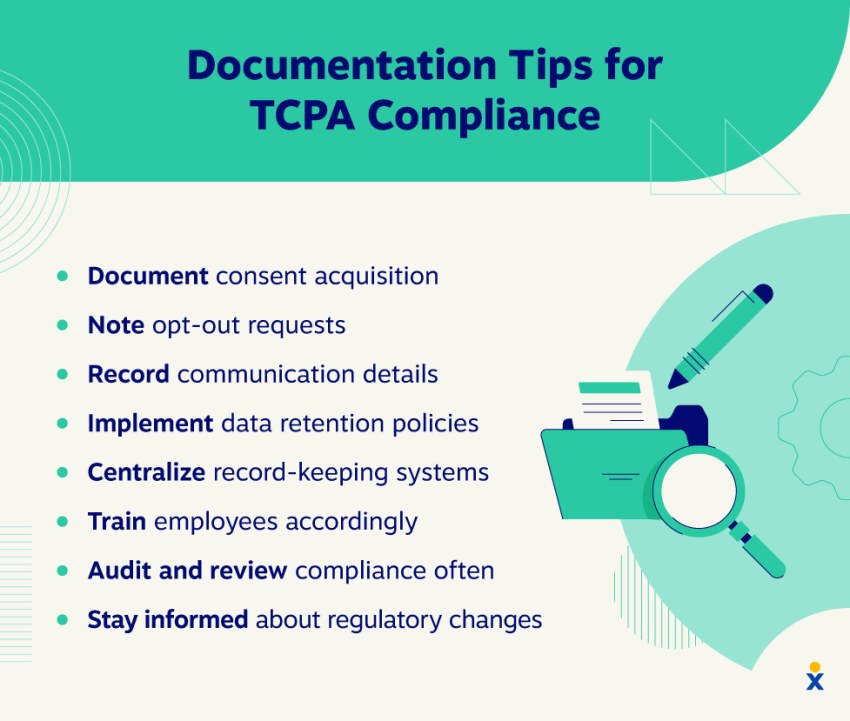
It’s best to respect the privacy of your prospects and configure the call center system in a way that makes you more efficient without compromising on compliance regulations.
Consider using a VoIP business phone system that allows caller ID rotation for improved pickup rates.
Automate intelligently
Don’t just automate for scale. Let automated dialing save time making connections, so you can focus on blending conversations with personalized scripting based on the segment. Contact center AI systems offer immense value in this case. They present real-time suggestions to keep calls relevant for leads and prospects.
Scott Clory, host of the Success Story podcast, says:

“Cold calls let you cut through the noise of the digital world to connect with decision makers. It’s personal and, when done right, leads to building a long-term, mutually beneficial relationship.”
~ Scott Clory
Doing it right involves the right technology driving your outreach strategy.
Even with automation, human skill matters. Provide sales representatives with dynamic scripts and coaching on how to handle objections. This becomes easier to execute with the help of AI-assisted live agent assist functionality. Use the technology to your benefit while keeping the human element alive.
Track the right metrics
Ensure you measure the right KPIs to make strategic improvements to streamline your call center workflows. Ideally, you should focus on:
- Connect (answer) rate: Dialers increase the percentage of calls that reach a live person. According to research, the cold-call connect rate is only 5%. The right dialer helps you push this higher.
- Talk time: These are the minutes you were actively engaged in a call with a prospect.
- Call volume: This is the total number of cold calls made in a specified period, which helps provide insights into how many calls typically result in a meeting for a particular prospect segment.
- Call-to-close ratio: This is the number of meetings scheduled or deals closed through cold calling. CallHippo’s research indicates that only 7% of calls become meetings or appointments.
Track these metrics consistently to make sure your workflows are correctly configured to deliver the best results.
Equip agents with context
Integrating your cold calling dialer with the CRM system provides the context you need to navigate prospects effectively during cold calls. This helps you add personalization to the conversation. You don’t look like you’re simply spamming prospects to repeat the same script that you have read on several other calls.
This personalization is like the oregano and chili flakes that you sprinkle on your pizza. Without it, the conversation just appears bland.
Nextiva: The Preferred Dialer for Outbound Sales Teams
Nextiva offers an AI-powered contact center solution that allows you to choose the dialer of your preference. It’s an all-in-one solution that delivers real-time analytics and omnichannel capabilities to engage prospects across various channels, not just calls.
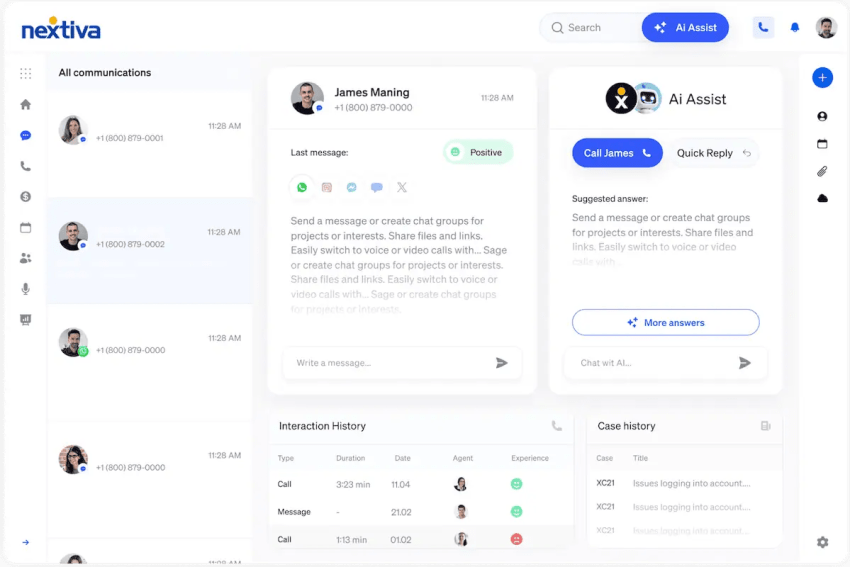
Alt text: Nextiva’s AI-powered dialer for cold calling and contact center workflows
It empowers contact center teams, overall customer support, or sales functions to run high-volume calling campaigns while executing different outreach strategies across channels.
With Nextiva, you get:
- Voicemail drop and call recording with outbound call flow
- Predictive, power, and preview dialer modes to match every calling strategy
- AI agent assists on live calls to suggest pivots and personalization elements in real time
- Real-time dashboards to track call and conversion rate metrics
- CRM integration and Zapier integration for streamlined workflow automation
- TCPA-compliant call routing and DNC list management
Explore Nextiva. Upgrade your cold call dialer to an AI-powered contact center solution. 👇
Top AI-Powered Contact Center Solution
Transform your customer interactions with a contact center platform that saves you time and money, reduces agent and supervisor stress, and flexibly adapts to fit your needs.


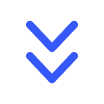














 Customer Experience
Customer Experience 








